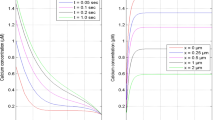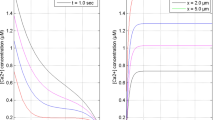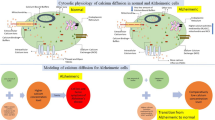Abstract
The mechanisms of calcium ([Ca2+]) signaling in various human cells have been widely analyzed by scientists due to its crucial role in human organs like the heartbeat, muscle contractions, bone activity, brain functionality, etc. No study is reported for interdependent [Ca2+] and IP3 mechanics regulating the release of ATP in neuron cells during Ischemia in Alzheimer’s disease advancement. In the present investigation, a finite element method (FEM) is framed to explore the interdependence of spatiotemporal [Ca2+] and IP3 signaling mechanics and its role in ATP release during Ischemia as well as in the advancement of Alzheimer’s disorder in neuron cells. The results provide us insights of the mutual spatiotemporal impacts of [Ca2+] and IP3 mechanics as well as their contributions to ATP release during Ischemia in neuron cells. The results obtained for the mechanics of interdependent systems differ significantly from the results of simple independent system mechanics and provide new information about the processes of the two systems. From this study, it is concluded that neuronal disorders cannot only be simply attributed to the disturbance caused directly in the processes of calcium signaling mechanics, but also to the disturbances caused in IP3 regulation mechanisms impacting the calcium regulation in the neuron cell and ATP release.















Similar content being viewed by others
Data availability
Not Applicable.
References
Ahmed Z, Connor JA (1988) Calcium regulation by and buffer capacity of molluscan neurons during calcium transients. Cell Calcium 9:57–69. https://doi.org/10.1016/0143-4160(88)90025-5
Allbritton NL, Meyer T, Stryer L (1992) Range of messenger action of calcium ion and inositol 1,4,5-trisphosphate. Science 258(80):1812–1815. https://doi.org/10.1126/science.1465619
Atri A, Amundson J, Clapham D, Sneyd J (1993) A single-pool model for intracellular calcium oscillations and waves in the Xenopus laevis oocyte. Biophys J 65:1727–1739. https://doi.org/10.1016/S0006-3495(93)81191-3
Berridge MJ, Irvine RF (1984) Inositol trisphosphate, a novel second messenger in cellular signal transduction. Nature 312:315–321. https://doi.org/10.1038/312315a0
Berridge MJ, Lipp P, Bootman MD (2000) The versatility and universality of calcium signalling. Nat Rev Mol Cell Biol 11(1):11–21. https://doi.org/10.1038/35036035
Bezprozvanny I, Watras J, Ehrlich BE (1991) Bell-shaped calcium-response curves of lns(l,4,5)P3- and calcium-gated channels from endoplasmic reticulum of cerebellum. Nature 351:751–754. https://doi.org/10.1038/351751a0
Bodalia A, Li H, Jackson MF (2013) Loss of endoplasmic reticulum Ca2+ homeostasis: contribution to neuronal cell death during cerebral ischemia. Acta Pharmacol Sin 34:49–59. https://doi.org/10.1038/aps.2012.139
Bootman MD, Berridge MJ (1995) The elemental principles of calcium signaling. Cell 83:675–678. https://doi.org/10.1016/0092-8674(95)90179-5
Brini M, Calì T, Ottolini D, Carafoli E (2014) Neuronal calcium signaling: function and dysfunction. Cell Mol Life Sci 71:2787–2814. https://doi.org/10.1007/s00018-013-1550-7
Brown SA, Morgan F, Watras J, Loew LM (2008) Analysis of phosphatidylinositol-4,5-bisphosphate signaling in cerebellar Purkinje spines. Biophys J 95:1795–1812. https://doi.org/10.1529/biophysj.108.130195
Bugrim A, Fontanilla R, Eutenier BB et al (2003) Sperm initiate a Ca2+ wave in frog eggs that is more similar to Ca2+ waves initiated by IP3 than by Ca2+. Biophys J 84:1580–1590. https://doi.org/10.1016/S0006-3495(03)74968-6
Bull R, Finkelstein JP, Gálvez J et al (2008) Ischemia enhances activation by Ca2+ and redox modification of ryanodine receptor channels from rat brain cortex. J Neurosci 28:9463–9472. https://doi.org/10.1523/JNEUROSCI.2286-08.2008
Choi DW (1988) Calcium-mediated neurotoxicity: relationship to specific channel types and role in ischemic damage. Trends Neurosci 11:465–469. https://doi.org/10.1016/0166-2236(88)90200-7
Chung JW, Ryu WS, Kim BJ, Yoon BW (2015) Elevated calcium after acute ischemic stroke: association with a poor short-term outcome and long-term mortality. J Stroke 17:54–59. https://doi.org/10.5853/jos.2015.17.1.54
Crank J (1979) The mathematics of diffusion. Oxford University Press, Ely House
Dave DD, Jha BK (2018) Delineation of calcium diffusion in Alzheimeric brain. J Mech Med Biol 18:1–15. https://doi.org/10.1142/S0219519418500288
Dave DD, Jha BK (2021) 2D finite element estimation of calcium diffusion in Alzheimer’s affected neuron. Netw Model Anal Heal Inf Bioinform 10:1–11. https://doi.org/10.1007/s13721-021-00322-6
Deshpande JK, Siesjo BK, Wieloch T (1987) Calcium accumulation and neuronal damage in the rat hippocampus following cerebral ischemia. J Cereb Blood Flow Metab 7:89–95. https://doi.org/10.1038/jcbfm.1987.13
Falcke M (2003) Buffers and oscillations in intracellular Ca2+ dynamics. Biophys J 84:28–41. https://doi.org/10.1016/S0006-3495(03)74830-9
Falcke M, Huerta R, Rabinovich MI et al (2000) Modeling observed chaotic oscillations in bursting neurons: the role of calcium dynamics and IP3. Biol Cybern 82:517–527. https://doi.org/10.1007/s004220050604
Fink CC, Slepchenko B, Moraru II et al (2000) An image-based model of calcium waves in differentiated neuroblastoma cells. Biophys J 79:163–183. https://doi.org/10.1016/S0006-3495(00)76281-3
Fogelson AL, Zucker RS (1985) Presynaptic calcium diffusion from various arrays of single channels. Implications for transmitter release and synaptic facilitation. Biophys J 48:1003–1017. https://doi.org/10.1016/S0006-3495(85)83863-7
Jagtap YD, Adlakha N (2018) Simulation of buffered advection diffusion of calcium in a hepatocyte cell. Math Biol Bioinform 13:609–619. https://doi.org/10.17537/2018.13.609
Jagtap Y, Adlakha N (2019) Numerical study of one-dimensional buffered advection–diffusion of calcium and IP3 in a hepatocyte cell. Netw Model Anal Heal Inf Bioinform 8:1–9. https://doi.org/10.1007/s13721-019-0205-5
Jha A, Adlakha N (2015) Two-dimensional finite element model to study unsteady state Ca2+ diffusion in neuron involving ER LEAK and SERCA. Int J Biomath. https://doi.org/10.1142/S1793524515500023
Jha BK, Adlakha N, Mehta MN (2013) Two-dimensional finite element model to study calcium distribution in astrocytes in presence of VGCC and excess buffer. Int J Model Simul Sci Comput. https://doi.org/10.1142/S1793962312500304
Jha BK, Adlakha N, Mehta MN (2014) Two-dimensional finite element model to study calcium distribution in astrocytes in presence of excess buffer. Int J Biomath 7:1–11. https://doi.org/10.1142/S1793524514500314
Kalaria RN (2000) The role of cerebral ischemia in Alzheimer’s disease. Neurobiol Aging 21:321–330. https://doi.org/10.1016/S0197-4580(00)00125-1
Keener J, Sneyd J (2009) Mathematical physiology, 2nd edn. Springer, New York. https://doi.org/10.1007/978-0-387-75847-3
Keizer J, De Young G (1993) Effect of voltage-gated plasma membrane Ca2+ fluxes on IP3-linked Ca2+ oscillations. Cell Calcium 14:397–410. https://doi.org/10.1016/0143-4160(93)90044-7
Koistinaho M, Koistinaho J (2005) Interactions between Alzheimer’s disease and cerebral ischemia—focus on inflammation. Brain Res Rev 48:240–250. https://doi.org/10.1016/j.brainresrev.2004.12.014
Kotwani M, Adlakha N, Mehta MN (2012) Numerical model to study calcium diffusion in fibroblasts cell for one dimensional unsteady state case. Appl Math Sci 6:5063–5072
Kotwani M, Adlakha N, Mehta MN (2014) Finite element model to study the effect of buffers, source amplitude and source geometry on spatiooral calcium distribution in fibroblast cell. J Med Imaging Heal Inf 4:840–847. https://doi.org/10.1166/jmihi.2014.1328
Li YX, Rinzel J (1994) Equations for InsP3 receptor-mediated [Ca2+](i) oscillations derived from a detailed kinetic model: a hodgkin-huxley like formalism. J Theor Biol 166:461–473. https://doi.org/10.1006/jtbi.1994.1041
Llinas R (1979) The role of calcium in neuronal function. Neurosci Fourth Study Progr 51:555–571
Manhas N, Anbazhagan N (2021) A mathematical model of intricate calcium dynamics and modulation of calcium signalling by mitochondria in pancreatic acinar cells. Chaos Solitons Fractals 145:9–12. https://doi.org/10.1016/j.chaos.2021.110741
Manhas N, Pardasani KR (2014) Mathematical model to study IP3 dynamics dependent calcium oscillations in pancreatic acinar cells. J Med Imaging Heal Inf 4:874–880. https://doi.org/10.1166/jmihi.2014.1333
Manhas N, Sneyd J, Pardasani KR (2014) Modelling the transition from simple to complex Ca2+oscillations in pancreatic acinar cells. J Biosci 39:463–484. https://doi.org/10.1007/s12038-014-9430-3
Mattson MP, Zhu H, Yu J, Kindy MS (2000) Presenilin-1 mutation increases neuronal vulnerability to focal ischemia in vivo and to hypoxia and glucose deprivation in cell culture: Involvement of perturbed calcium homeostasis. J Neurosci 20:1358–1364. https://doi.org/10.1523/jneurosci.20-04-01358.2000
Michell RH (1975) Inositol phospholipids and cell surface receptor function. BBA Rev Biomembr 415:81–147. https://doi.org/10.1016/0304-4157(75)90017-9
Naik PA, Pardasani KR (2015) One dimensional finite element model to study calcium distribution in oocytes in presence of VGCC, RyR and buffers. J Med Imaging Heal Inf 5:471–476. https://doi.org/10.1166/jmihi.2015.1431
Naik PA, Pardasani KR (2016) Finite element model to study calcium distribution in oocytes involving voltage gated Ca2+ channel, ryanodine receptor and buffers. Alexandria J Med 52:43–49. https://doi.org/10.1016/j.ajme.2015.02.002
Naik PA, Pardasani KR (2019) Three-dimensional finite element model to study effect of RyR calcium channel, ER leak and SERCA pump on calcium distribution in oocyte cell. Int J Comput Methods 16:1–19. https://doi.org/10.1142/S0219876218500913
Nelson DL, Cox MM (2005) Lehninger principles of biochemistry, 4th edn. WH Freeman and Company, New York
Öziş T, Aksan EN, Özdeş A (2003) A finite element approach for solution of Burgers’ equation. Appl Math Comput 139:417–428. https://doi.org/10.1016/S0096-3003(02)00204-7
Panday S, Pardasani KR (2013) Finite element model to study effect of advection diffusion and Na +/Ca2+ exchanger on Ca2+ distribution in oocytes. J Med Imaging Heal Inf 3:374–379. https://doi.org/10.1166/jmihi.2013.1184
Pathak KB, Adlakha N (2015) Finite element model to study calcium signalling in cardiac myocytes involving pump, leak and excess buffer. J Med Imaging Heal Inf 5:683–688. https://doi.org/10.1166/jmihi.2015.1443
Pathak K, Adlakha N (2016) Finite element model to study two dimensional unsteady state calcium distribution in cardiac myocytes. Alexandria J Med 52:261–268. https://doi.org/10.1016/j.ajme.2015.09.007
Pawar A, Pardasani KR (2022a) Effect of disturbances in neuronal calcium and IP3 dynamics on β-amyloid production and degradation. Cogn Neurodyn 2022:1–18. https://doi.org/10.1007/S11571-022-09815-0
Pawar A, Pardasani KR (2022b) Simulation of disturbances in interdependent calcium and β-amyloid dynamics in the nerve cell. Eur Phys J Plus 1378(137):1–23. https://doi.org/10.1140/EPJP/S13360-022-03164-X
Pawar A, Pardasani KR (2022c) Study of disorders in regulatory spatiotemporal neurodynamics of calcium and nitric oxide. Cogn Neurodyn. https://doi.org/10.1007/s11571-022-09902-2
Pawar A, Pardasani KR (2022d) Effects of disorders in interdependent calcium and IP3 dynamics on nitric oxide production in a neuron cell. Eur Phys J Plus 137:543. https://doi.org/10.1140/EPJP/S13360-022-02743-2
Pawar A, Pardasani KR (2023) Computational model of calcium dynamics-dependent dopamine regulation and dysregulation in a dopaminergic neuron cell. Eur Phys J Plus 123:1–19. https://doi.org/10.1140/epjp/s13360-023-03691-1
Pluta R, Jabłoński M, Ułamek-Kozioł M et al (2013) Sporadic Alzheimer’s disease begins as episodes of brain ischemia and ischemically dysregulated alzheimer’s disease genes. Mol Neurobiol 48:500–515. https://doi.org/10.1007/s12035-013-8439-1
Pluta R, Januszewski S, Czuczwar SJ (2021) Brain ischemia as a prelude to Alzheimer’s disease. Front Aging Neurosci 13:1–12. https://doi.org/10.3389/fnagi.2021.636653
Rasmussen H, Barrett PQ (1984) Calcium messenger system: an integrated view. Physiol Rev 64:938–984. https://doi.org/10.1152/physrev.1984.64.3.938
Rossi DJ, Brady JD, Mohr C (2007) Astrocyte metabolism and signaling during brain ischemia. Nat Neurosci 10:1377–1386. https://doi.org/10.1038/nn2004
Ruiz A, Matute C, Alberdi E (2009) Endoplasmic reticulum Ca2+ release through ryanodine and IP3 receptors contributes to neuronal excitotoxicity. Cell Calcium 46:273–281. https://doi.org/10.1016/j.ceca.2009.08.005
Siesjö BK (1984) Cell damage in the brain: a speculative synthesis. Acta Psychiatr Scand 70:57–91. https://doi.org/10.1111/j.1600-0447.1984.tb07154.x
Sims CE, Allbrittont NL (1998) Metabolism of inositol 1,4,5-trisphosphate and inositol 1,3,4,5- tetrakisphosphate by the oocytes of Xenopus laevis. J Biol Chem 273:4052–4058. https://doi.org/10.1074/jbc.273.7.4052
Singh N, Adlakha N (2019) Nonlinear dynamic modeling of 2-dimensional interdependent calcium and inositol 1,4,5-trisphosphate in cardiac myocyte. Math Biol Bioinform 14:290–305. https://doi.org/10.17537/2019.14.290
Singh N, Adlakha N (2020) Effect of source geometry on interdependent calcium and inositol 1; 4; 5-trisphosphate dynamics in a cardiac myocyte cell. Springer Proc Math Stat 308:75–83. https://doi.org/10.1007/978-981-15-1338-1_6
Smith GD (1996) Analytical steady-state solution to the rapid buffering approximation near an open Ca2+ channel. Biophys J 71:3064–3072. https://doi.org/10.1016/S0006-3495(96)79500-0
Smith GD, Wagner J, Keizer J (1996) Validity of the rapid buffering approximation near a point source of calcium ions. Biophys J 70:2527–2539. https://doi.org/10.1016/S0006-3495(96)79824-7
Stamatakis M, Mantzaris NV (2006) Modeling of ATP-mediated signal transduction and wave propagation in astrocytic cellular networks. J Theor Biol 241:649–668. https://doi.org/10.1016/j.jtbi.2006.01.002
Stutzmann GE, Mattson MP (2011) Endoplasmic reticulum Ca2+ handling in excitable cells in health and disease. Pharmacol Rev 63:700–727. https://doi.org/10.1124/pr.110.003814
Tewari S, Pardasani KR (2008) Finite difference model to study the effects of Na+ influx on cytosolic Ca2+ diffusion. World Acad Sci Eng Technol 2:670–675
Tewari SG, Pardasani KR (2010) Finite element model to study two dimensional unsteady state cytosolic calcium diffusion in presence of excess buffers. IAENG Int J Appl Math 40:1–5. https://www.iaeng.org/IJAM/issues_v40/issue_3
Tewari SG, Pardasani KR (2012) Modeling effect of sodium pump on calcium oscillations in neuron cells. J Multiscale Model 04:1250010. https://doi.org/10.1142/s1756973712500102
Tewari V, Tewari S, Pardasani KR (2011) A model to study the effect of excess buffers and Na + ions on Ca2+ diffusion in neuron cell. World Acad Sci Eng Technol 76:41–46. https://doi.org/10.5281/zenodo.1054988
Tripathi A, Adlakha N (2011) Closed form solution to problem of calcium diffusion in cylindrical shaped neuron cell. World Acad Sci Eng Technol 80:739–742. https://doi.org/10.5281/zenodo.1078819
Tripathi A, Adlakha N (2012) Two dimensional coaxial circular elements in FEM to study calcium diffusion in neuron cells. Appl Math Sci 6:455–466
Tymianski M, Tator C (1996) Normal and abnormal calcium homeostasis in neurons: a basis for the pathophysiology of traumatic and ischemic central nervous system injury. Neurosurgery 38:1176–1195. https://doi.org/10.1097/00006123-199606000-00028
Verkhratsky A (2002) The endoplasmic reticulum and neuronal calcium signalling. Cell Calcium 32:393–404. https://doi.org/10.1016/S0143416002001896
Volonté C, Amadio S, Cavaliere F et al (2003) Extracellular ATP and neurodegeneration. Curr Drug Targets CNS Neurol Disord 2:403–412. https://doi.org/10.2174/1568007033482643
Wagner J, Keizer J (1994) Effects of rapid buffers on Ca2+ diffusion and Ca2+ oscillations. Biophys J 67:447–456. https://doi.org/10.1016/S0006-3495(94)80500-4
Wagner J, Fall CF, Hong F et al (2004) A wave of IP3 production accompanies the fertilization Ca2+ wave in the egg of the frog, Xenopus laevis: theoretical and experimental support. Cell Calcium 35:433–447. https://doi.org/10.1016/j.ceca.2003.10.009
Wojda U, Salinska E, Kuznicki J (2008) Calcium ions in neuronal degeneration. IUBMB Life 60:575–590. https://doi.org/10.1002/iub.91
Yanagihara T, John TM (1982) Ionic shift in cerebral ischemia. Life Sci 30:1921–1925. https://doi.org/10.1016/0024-3205(82)90473-8
Funding
Not Available.
Author information
Authors and Affiliations
Contributions
We both authors contributed equally to this paper in terms of problem formulation, solution, data correction/literature review, and interpretation of the findings. Author (1) developed the Matlab program.
Corresponding author
Ethics declarations
Conflict of interest
The authors of this work state that they have no competing interests.
Ethical approval
Not Applicable.
Additional information
Publisher's Note
Springer Nature remains neutral with regard to jurisdictional claims in published maps and institutional affiliations.
Appendix: Model equations summary
Appendix: Model equations summary
The FEM is a numerical-cum-analytical technique for solving boundary value problems. It involves the discretization of the domain into a finite number of sub-regions and then the solution of each sub-region is obtained by substituting an interpolation function. The solution of each sub-region is assembled to obtain the solution for the whole region. Here, Galerkin’s approach is used to obtain the variational form. The unsteady state models of [Ca2+] and IP3 diffusion concerning the one-dimensional case in neuron cells are constructed. The present problem is to get the solutions of Eq. (7) coupled with Eqs. (23, 25 and 26) concerning [Ca2+] and Eq. (17) coupled with Eqs. (24, 27 and 28) concerning IP3. The length of the region is considered to be 5 µm, and divided into 40 elements from the source location to 5 µm. The initial and boundary conditions were constructed in light of biophysical conditions. The model equations for [Ca2+] and IP3 dynamics are transformed into the variational form and Galerkin’s finite element procedure was utilized to get the solution. Conveniently, the notations ‘u’ and ‘v’ are used instead of [Ca2+] and IP3 and e = 1, 2, 3,…, 40. Also, e depicts the eth element and xi and xi+1 depict the initial and terminal nodes of the eth element.
For [Ca2+] and IP3 distribution, shape functions for each element is considered as,
Putting nodal conditions in Eq. (34),
where,
From Eq. (36), we get
And
Substituting \({\text{q}}^{{\text{(e)}}}\) and \({\text{r}}^{{\text{(e)}}}\) from Eq. (38) in (34),
The integrals \({\text{I}}_{{1}}^{{\text{(e)}}}\) and \({\text{I}}_{{2}}^{{\text{(e)}}}\) represent discretized variational forms of Eqs. (7) and (17). These forms are given below;
where
The various coefficients \(\alpha _{1} ,{\text{ }}\alpha _{2} ,{\text{ }}\alpha _{3} ,{\text{ }}\beta _{1} ,{\text{ }}\beta _{2} ,{\text{ }}\theta _{1} ,{\text{ }}\theta _{2} ,{\text{ }}\mu _{1} ,{\text{ }}\mu _{2} ,{\text{ }}\delta _{1} ,{\text{ }}\delta _{2} ,{\text{ and}},{\text{ }}\delta _{3}\) are determined by the linearization procedure for nonlinear terms of [Ca2+] and IP3 distributions. The boundary conditions are incorporated in the analyzed equations to provide the system of equations as follows.
where,
Here, A and B are system matrices with F as system vectors. The numerically stable Crank–Nicolson technique is utilized in FEM for time derivatives solution.
Rights and permissions
Springer Nature or its licensor (e.g. a society or other partner) holds exclusive rights to this article under a publishing agreement with the author(s) or other rightsholder(s); author self-archiving of the accepted manuscript version of this article is solely governed by the terms of such publishing agreement and applicable law.
About this article
Cite this article
Pawar, A., Pardasani, K.R. Mechanistic insights of neuronal calcium and IP3 signaling system regulating ATP release during ischemia in progression of Alzheimer’s disease. Eur Biophys J 52, 153–173 (2023). https://doi.org/10.1007/s00249-023-01660-1
Received:
Revised:
Accepted:
Published:
Issue Date:
DOI: https://doi.org/10.1007/s00249-023-01660-1




